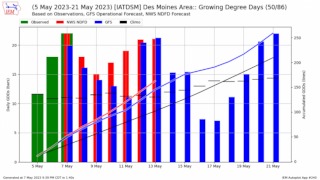By Meaghan Anderson
The beautiful weather this past week means we’ll see a substantial increase in planted acres on this week’s Crop Progress and Condition Report. Farmers should carefully evaluate their herbicide choices before spraying any planted soybean fields that didn’t get their preemergence (PRE) herbicide on ahead of the rain over the weekend. It is always important to read and follow the label – it’s the law after all. Before hitting the fields, check the labels for the herbicides in your PRE mixture to be sure they are still safe to apply.
While most corn PRE herbicides have flexibility to apply after corn emergence, many soybean PRE products are more restrictive on application timing. Some herbicides may only be applied up to three days after planting, including products containing flumioxazin (Valor) and sulfentrazone (Spartan, Authority). Additionally, any product containing metribuzin cannot be applied to emerged soybean in Iowa.
Making PRE applications after planting this year may be especially risky due to the recent rainfall and warm temperatures. Current weather forecasts predict that soybeans planted Friday, May 5 could accumulate nearly 100 growing degree days (GDDs) by Tuesday, May 9. It is likely that some soybean seedlings could be near emergence just 5 days after planting this year. Soybeans at or just prior to emergence of the cotyledons will be at greatest risk for injury from one of these PRE applications or a rainfall event that moves substantial herbicide onto the seedlings or into cracked furrows.

Figure 1. GDD accumulation estimates on May 5 planted soybean based on two weather forecasts for Des Moines, IA. Source: Iowa Environmental Mesonet Autoplot #240, Daryl Herzmann.
If your planter got too far ahead of the sprayer and you’ll miss the window for your PRE application, alternative options exist to avoid damaging soybean seedlings and provide good weed control. Farmers may choose to switch the above active ingredients to a Group 15-based program with metolachlor (metolachlor), acetochlor (Warrant), dimethenamid (Outlook), pyroxasulfone (Zidua), or mixtures containing Group 14 active ingredient fomesafen (like Prefix) for waterhemp control.
Products containing fomesafen, 2,4-D, dicamba, or glufosinate (Liberty) will be effective in tank mixes if waterhemp has emerged prior to application, and the appropriate choice depends on numerous factors including weather conditions, plant size, and crop tolerance. Numerous Group 2 herbicides are also labeled for early POST. While Group 2 herbicides are ineffective for waterhemp control, they can improve the spectrum of control for other species (particularly large-seeded ones) like common cocklebur, velvetleaf, and giant ragweed.
While the rainfall was beneficial for everyone, get the season off to a great start by making sure your herbicide applications won’t set your soybeans back. Reach out to your Iowa State University Extension and Outreach field agronomist for local recommendations.
Source : iastate.edu